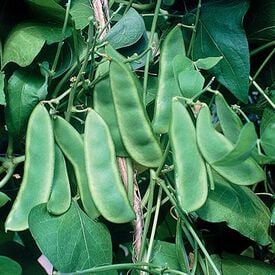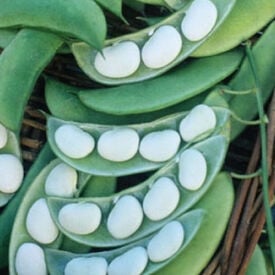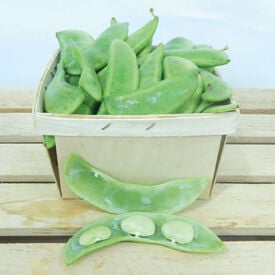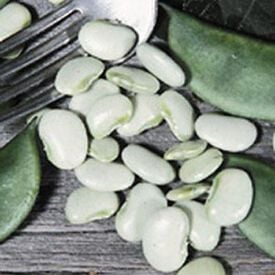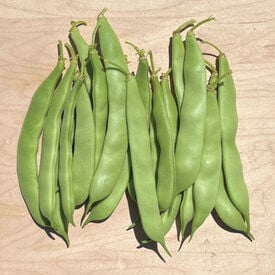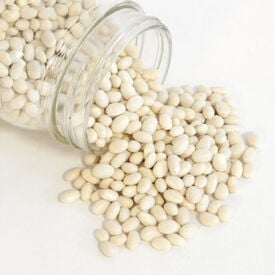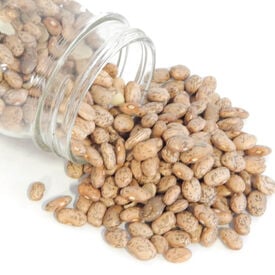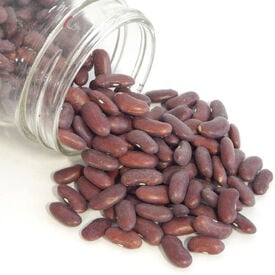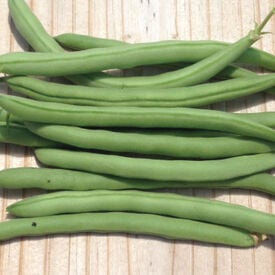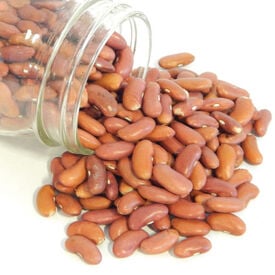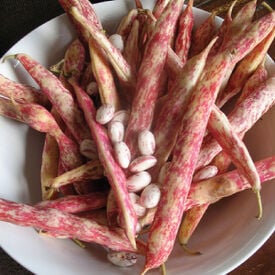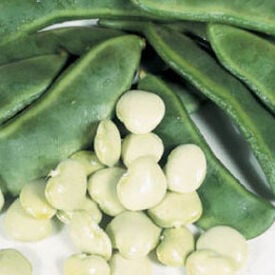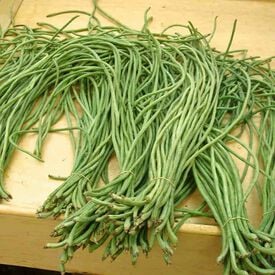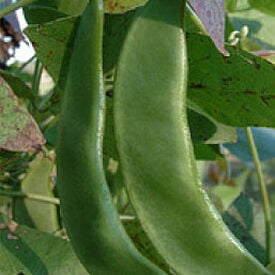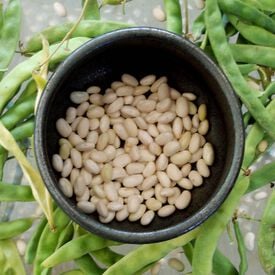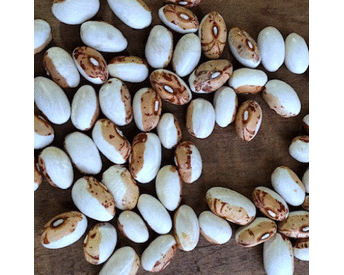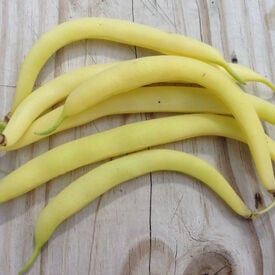Learn More
The small Woods Prolific Lima Bean is perfect for canning, freezing and as a dry bean! The bean plant produces thick green pods with small creamy white seeds. Each pod contains about 3 to 4 seeds. The Woods Prolific Lima Bean prefers full sun and has early to mid maturity and produces continuously until frost.
The Burpee Improved Bush Lime bean plants produce large pods, high yields, and perfectly shaped beans. Burpee Improved beans are both larger and thicker than normal lima beans. The growth is even more vigorous, with heavier foliage. The plants are uniformly upright.
Fordhook 242 is a popular variety of bush bean known for its exceptional flavor and versatility in the garden. These beans have a rich history, dating back to the early 20th century when they were first introduced by the W. Atlee Burpee Seed Company. Fordhook 242 beans belong to the Phaseolus vulgaris species and are a type of snap or green bean, which means they are typically eaten in their immature, tender pod stage. In terms of taste, Fordhook 242 beans are celebrated for their crisp and tender texture, as well as their mild, sweet, and slightly nutty flavor. They are a favorite among gardeners and cooks alike, making them a versatile choice for various culinary applications. The plants of Fordhook 242 are compact and bushy, reaching a height of about 18 to 24 inches. They are known for their quick maturity, typically taking around 50 to 55 days from planting to harvest. The pods are a vibrant green color, elongated, and measure about 6 to 7 inches in length. This variety is prized for its disease resistance, particularly against common bean diseases like mosaic virus and bacterial brown spot. Fordhook 242 beans are known to yield approximately 5-8 pounds of beans per 10-foot row, making them a productive choice for home gardeners. Proper spacing is crucial for healthy growth, with plants typically spaced about 3-4 inches apart in rows that are 18-24 inches apart. These beans thrive in well-drained, fertile soil and require full sun exposure for optimal growth. With their excellent taste, disease resistance, and reliable yield, Fordhook 242 beans are a fantastic addition to any vegetable garden.
The Eastland bean, scientifically known as Phaseolus vulgaris 'Eastland,' is a popular variety of bush bean that hails from the United States. It is highly esteemed for its exceptional taste and ease of cultivation. Eastland beans belong to the family Fabaceae and are a warm-season crop commonly grown in gardens and small-scale farms. In terms of taste, Eastland beans are celebrated for their tender, crisp texture and rich, earthy flavor. They are a delight to eat both raw and cooked. The pods of Eastland beans are of medium size, typically measuring around 4-5 inches in length. The plants themselves are compact and bushy, making them suitable for smaller gardens and spaces. These beans have a relatively short maturity period, typically taking around 70-75 days from planting to harvest. The beans are known for their vibrant green color, making them visually appealing as well. Eastland beans are generally resistant to common bean diseases such as bean mosaic virus and rust. They are known to provide a good yield per acre, often ranging from 800 to 1,200 pounds of beans per acre, depending on growing conditions and care. Proper spacing is crucial for their growth, with plants typically spaced 3-4 inches apart in rows that are about 18-24 inches apart. These beans thrive in well-drained soil with full sun exposure and require regular watering to maintain consistent moisture levels in the soil. Overall, Eastland beans are a favorite among gardeners and farmers for their taste, disease resistance, and relatively quick harvest time.
The Taylor Dwarf Horticulture Bean, also known as the Taylor Horticulture Bean or simply Taylor Dwarf Bean, is a popular heirloom bean variety prized for its delicious flavor and historical significance. This bean variety has a rich history dating back to the early 19th century in the United States. It is a bush-type bean, which means it grows in a compact, bushy form rather than climbing like pole beans. Taylor Dwarf Horticulture Beans are highly regarded for their superb taste, which is characterized by a creamy texture and a slightly nutty, earthy flavor. The beans are typically harvested when they are young and tender, making them ideal for fresh consumption or canning. The pods of the Taylor Dwarf Horticulture Bean are medium-sized and typically measure around 4-5 inches in length. The plants themselves are relatively small and bushy, reaching a height of about 18-24 inches, which makes them suitable for smaller gardens or container gardening. This variety has a relatively short maturity period, typically taking around 55-60 days from planting to harvest. The beans themselves are a pale cream or off-white color. Taylor Dwarf Horticulture Beans are known for their good disease resistance, which helps ensure a healthy crop. In terms of yield, you can expect a respectable harvest of beans per row, with each plant producing multiple pods. Proper spacing between plants should be around 4-6 inches apart in rows that are spaced about 18-24 inches apart. These beans thrive in well-drained soil with good organic matter content and prefer full sun for optimal growth. Adequate moisture and regular harvesting will help ensure a bountiful crop of these delicious and historically significant beans.
Navy beans, scientifically known as Phaseolus vulgaris, are small, oval-shaped beans that are a popular and versatile member of the legume family. They are often referred to as navy beans due to their association with the United States Navy, where they were a staple food for sailors in the 19th century. These beans have a rich history dating back to ancient times when they were cultivated by indigenous peoples in the Americas. They were later introduced to Europe by Spanish explorers and became an essential part of global cuisine. Navy beans have a mild, nutty flavor and a smooth, creamy texture when cooked. They are known for their ability to absorb the flavors of the ingredients they are cooked with, making them a favorite in soups, stews, and baked bean dishes. These beans are typically small, about half an inch in length, and are usually white or off-white in color, although there are variations with speckled or colored coats. In terms of plant characteristics, navy bean plants are relatively compact, reaching a height of about 18 to 24 inches. They have a bushy growth habit and produce small, white or lavender flowers before developing pods that contain the beans. Navy beans typically take around 80 to 90 days to reach maturity, making them a relatively quick-growing crop. They thrive in well-drained soil with good moisture retention and prefer full sun for optimal growth. Adequate spacing and support may be needed to ensure healthy plant development, and they are generally grown as annuals in most regions.
The Pinto bean is a great tasting bean, very popular in many Mexican dishes! The Pinto bean plant is a half-runner type that produces 20 inch plants with light tan seeds with brown speckles. Eat young when green for delicious flavor. Great bean for using for refried beans.
Our soup blend allows you to grow your own delicious bean soup. Our "Bean Soup" seed blend is equal blends of Vermont Cranberry Shell, Blackeye #5, Light Red Kidney, Dark Red Kidney, Pinto and Navy bean seeds. This combination creates a rich and creamy bean soup that is a delight to eat!
Dark Red Kidney beans are one of the most widely used beans in North America! Dark Red Kidney is a bush variety of dried bean. Each pod contains 5 large, red kidney shaped beans. If rain threatens before your beans are totally dry, pull the whole plant up, hang upside down in your barn/garage to let them finish drying. Once dry, these beans will store for a long time! This bean is often used in Mexican food.A perfect winter food full of protein straight from your own garden.
The Topcrop bean is a great bean for canning and freezing. Topcrop got its name for a reason. This bean plant grows a heavy, concentrated set of beans. One of the best known beans around. Harvest on the early side of maturity to get small and tender beans. Delicious eaten fresh off the vine!
The Light Red Kidney Bean is a popular kidney bean that has mild bean flavor! Excellent for chili, bean salads, and soups. Exceptional culinary quality, with silky texture and thin skin. Plants grow to medium size that are sturdy and widely adapted. Produce well anywhere in the United States.
The Vermont Cranberry Shell bean is an incredible bean variety that can be used as a snap, shell or dry bean. Cranberry Shell stores exceptionally well. Maroon colored beans are decorated with darker red, cranberry markings. This variety dates back to the 1800s and is well-suited to short-season, cool summer climates.
Henderson is the ultimate popular baby Lima. Henderson offers great tasting, smaller beans, that are perfect for cooking with any meal.
A beautifully bright and vibrant green bean that grows extra long when mature! Matures quick and has a delicious and crisp bite.
King of the Garden is a heavy yielding lima bean. This variety is our best freezing bean variety! They come out of the freezer just like they were put in. A great top pole Lima bean. Great freezing bean. Also a heavy long-term yielder.
The great northern bean is an heirloom bean variety that is perfect for drying and using in different baked dishes. Semi-vining, 24 inch plants yield a prolific quantity of flat, 5 inch pods holding 5 to 6, large white beans.
The Hidatsa Shield bean is an old heirloom grown by the Hidatsa Indians. Deep in the Missouri River Valley of North Dakota the Hidatsa Indians grew this pole type drying bean in their corn fields. The Indians were masters of growing plants that were helpful to each other such as the "Three Sisters".
Cherokee Wax beans, also known as Cherokee Yellow Wax beans, are a popular variety of bush beans cherished for their vibrant appearance and delicious flavor. These beans are believed to have originated from the Native American Cherokee tribe, hence their name. Cherokee Wax beans are a warm-season vegetable that thrives in various climates, making them a favorite among home gardeners and commercial growers alike. Cherokee Wax beans are known for their exceptional taste, boasting a mild, slightly sweet flavor with a tender and crisp texture. They are a type of bush bean, which means they grow as compact, bushy plants that don't require support structures. The pods of Cherokee Wax beans typically measure around 5 to 6 inches in length and have a bright yellow color. These beans have a relatively short time to maturity, usually taking about 50-55 days from planting to harvest. They are highly productive, yielding an impressive quantity of beans per 10-foot row. In terms of growing conditions, Cherokee Wax beans thrive in well-draining soil that receives full sun exposure. They require spacing of about 3-4 inches between plants and should be sown in rows that are 18-24 inches apart. Cherokee Wax beans are generally disease-resistant, with some varieties exhibiting resistance to common bean diseases like rust and mosaic virus. With proper care and regular harvesting, these beans can provide a bountiful and delicious addition to your garden or dinner table.
